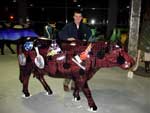The udderly amazing world of science
Published: 11 May 2006
The chemistry collaboration, ScotCHEM, will be represented at this year's Edinburgh CowParade
15 May 2006 will see the world's largest public art event, the CowParade, make its first foray into Scotland. Staff from Glasgow University's Chemistry Department have created a bovine beauty to join the herd.
Named 'Chem-moo-stry.org', the creation of Glasgow University researchers Andy Parkin and Gordon Barr will join over 100 cows to brighten the streets of Edinburgh from 15 May - 23 July. Funded by the major research collaboration ScotCHEM and the Royal Society of Chemistry, Chem-moo-stry.org displays some of the most cutting-edge chemistry research currently taking place, on the most unlikely background.
Co-creator Gordon Barr explained: 'We wanted to take Chemistry to a new audience. The general public perception of chemistry is that it is a bit dull and old-fashioned - CowParade certainly proves this opinion wrong. By bringing together the worlds of art and science we are showing that chemistry isn't all lab coats and test tubes. Chem-moo-stry.org certainly highlights the a-moo-sing side of chemistry in Scotland.'
Featuring graphical representations of research projects such as 'Moo-rine Chemistry', 'Electron Moo-croscopy' and 'Magnetic Moo-lecules', Chem-moo-stry.org highlights the work taking place in the seven institutions which make up ScotCHEM (the universities of Glasgow, Strathclyde, Edinburgh, St Andrews, Heriot Watt, Aberdeen and Dundee).
The Magnetic Moo-lecules project, led by Dr Mark Murrie at Glasgow University and Dr Euan Brechin at Edinburgh University, focuses on the development of single-molecule magnets (SMMs) which are being hailed as the future of computer memory chips. 'SMMs provide a tantalising glimpse of the future possibilities for high-density data storage for computers, with the potential to provide storage densities 25,000 times better than current technology,' explained Dr. Murrie.
President of the Royal Society of Chemistry, Simon Campbell, said: 'There is some excellent chemistry research going on in Scotland right now and the Chem-moo-stry.org cow will hopefully encourage more people to get interested in what these projects are, and in chemistry as a whole.'
'Chem-moo-stry.org is a novel way of highlighting the important research that is being done in chemistry departments at Scottish universities, it's an udderly brilliant project!' added Professor Chris Gilmore, of the University of Glasgow Chemistry Department.
To accompany the cow, Andy and Gordon have created a website which explains in more detail the projects displayed on Chem-moo-stry.org. This can be found at www.chem-moo-stry.org.
Kate Richardson (K.richardson@admin.gla.ac.uk)
CowParade: CowParade is the world?s largest public art event. From Chicago and New York in 1999 and 2000 to Kansas City and Houston in 2001 and London in 2002, CowParade is first and foremost a public art exhibit that is accessible to everyone. While the cow sculptures remain the same, each city?s artists are challenged by the art from past events, inspired by the cultural influences of their respective cities, and moved by their own interpretation of the cow as an art object.
For more information visit the Edinburgh CowParade website at http://edinburgh.cowparade.com/
ScotCHEM: The ScotCHEM initiative brings together the major players in chemistry research by joining two funded 'pairing' initiatives; WestCHEM comprising Glasgow and Strathclyde Universities and EastCHEM bringing together Edinburgh and St Andrews Universities. A separate Heriot-Watt initiative is also funded. Dundee and Aberdeen Universities are also involved and will benefit from the development of enhanced research networks and improved access to major research resources.
For more information visit the following websites:
ScotCHEM: http://www.scotchem.ac.uk/
WestCHEM: http://www.westchem.ac.uk/
EastCHEM: http://www.eastchem.ac.uk/
For more information on Chem-moo-stry.org, or to speak to the creators, please contact the University of Glasgow's Media Relations Office on 0141 330 3535 or email K.richardson@admin.gla.ac.uk
First published: 11 May 2006
<< May


